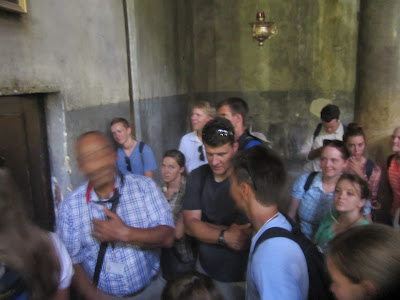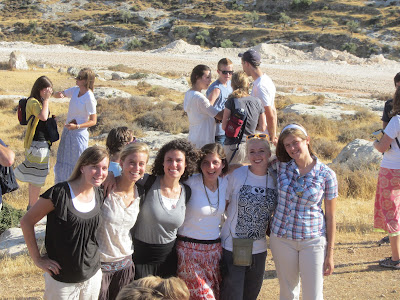Going to Bethlehem, where Jesus was born, is always a welcome and wonderful trip. In some ways it is a bit difficult, because it is in "Area A" of the West Bank, where the Palestinian Authority has full civil and security control, so getting there involves checkpoints, and we are always accompanied by some of our own center security to act as liaisons.
Everything went quite smoothly, though the visit was a bit bittersweet, because I realized that it would be the last time I would be going there (on this trip, at least). We go home in five weeks, which is hard to believe after having been here almost a year.
As usual, we began with a historical and archaeological site, the Herodion. We then went to Manger Square to visit the Basilica of the Nativity, St. Catherine's, and the ancient cave systems under the church. We then added a visit to Kenisat er-Ruwat, the Orthodox church in Bayt Sahour that commemorates the annunciation to the Shepherds. After lunch at the Tent Restaurant, we went to Khirbet Siyar el-Ghanem, the Catholic Shepherds Field after which we went to the open hillside north of Bethlehem and south of Har Homa to the site favored by Latter-day Saints to recall the fields where the shepherds were "abiding in the field, keeping watch over their flock by night." (Luke 2:8)
I have described these sites and posted many pictures in the past:
I am rather pressed for time today, so with the exception of a few details about the Orthodox and Catholic churches "at shepherds fields," I will, for the most past, simply post pictures of each site with my Summer 2012 students.
Egeria, a European pilgrim who wrote about her A.D. 381–384 visit to the Holy Land, recorded that there was a cave east of Bethlehem called "At the Shepherds." At her time, a church had already been established in the cave, which may well be the one on the grounds of Kenisat er-Ruwat. Three different churches were built in succession over the cave. While these now lie in ruin, a new church has been built nearby.

Even though it was hot sitting out on a dry, summer hillside, being on an open hillside looking over at Bethlehem was a moving experience. We read from Luke 2 and spoke of the Annunciation to and Adoration of the Shepherds. We then sang 7 or 8 Christmas carols. It was a wonderful time.
Everything went quite smoothly, though the visit was a bit bittersweet, because I realized that it would be the last time I would be going there (on this trip, at least). We go home in five weeks, which is hard to believe after having been here almost a year.
As usual, we began with a historical and archaeological site, the Herodion. We then went to Manger Square to visit the Basilica of the Nativity, St. Catherine's, and the ancient cave systems under the church. We then added a visit to Kenisat er-Ruwat, the Orthodox church in Bayt Sahour that commemorates the annunciation to the Shepherds. After lunch at the Tent Restaurant, we went to Khirbet Siyar el-Ghanem, the Catholic Shepherds Field after which we went to the open hillside north of Bethlehem and south of Har Homa to the site favored by Latter-day Saints to recall the fields where the shepherds were "abiding in the field, keeping watch over their flock by night." (Luke 2:8)
I have described these sites and posted many pictures in the past:
- Fall student trip to Bethlehem (November 1, 2011)
- Family picture taking trip to LDS Shepherds Field (among other sites on November 5, 2011)
- Christmas Eve in Bethlehem (December 24, 2011)
- Winter student trip to Bethlehem (March 13, 2012)
- Paul and Denise at Shepherds Field (at the end of the blog entry of their day in Jerusalem, April 21, 2012)
- Bruce and Vivienne at LDS Shepherds Field (at the end of their first day in Jerusalem, April 28, 2012)
I am rather pressed for time today, so with the exception of a few details about the Orthodox and Catholic churches "at shepherds fields," I will, for the most past, simply post pictures of each site with my Summer 2012 students.
Herodion
 |
| The Herodion was a fortress and palace on an artificially expanded conical hilltop |
 |
| Artist's depiction of the Herodion in its heyday |
 |
| Looking down from the top at the Lower Palace |
 |
| My class posing on the "island" in the massive swimming pool of the Lower Palace |
 |
| Layout of the fortress/Upper Palace |
 |
| Candid of Dr. Harper's class in the Upper Palace |
 |
| My class in a posed pic in the Upper Palace |
 |
| My class in the formal dining hall, that later Jewish rebels transformed into a synagogue . . . that is why the women and the men are divided! |
 |
| Some of my students being gargoyles (?) in the water tunnels |
Manger Square
 |
| Meeting our guide, Jalaab |
 |
| The Basilica of the Nativity is the oldest, continually-in-use church in the world |
 |
| Entering the small door, reduced three times in its history |
 |
| In the Roman Catholic church of St. Catherine's, next to to Basilica of the Nativity. This is the place from which the Catholic Christmas Eve mass is broadcast each year |
 |
| Stained glass window of the Nativity |
 |
| The cave system beneath the churches. From the earliest years of Christianity, tradition has held that Jesus was born somewhere in these caves. |
 |
| Rachel and I in the faves near the Grotto of St. Jerome |
 |
| My students singing as part of our devotional |
 |
| Inside the Basilica of the Nativity |
 |
| Steve and his students waiting in line to descend into the grotto below the altar |
 |
| Rachel in line to go down into the grotto to see the traditional birth place |
 |
| Rachel about to end the grotto |
 |
| With Rachel by the 14-pointed star that marks the traditional spot of Jesus' birth |
 |
| Rachel by the altar marking the spot where Mary lay the Baby Jesus in the manger |
 |
| My students in the basilica |
 |
| The mosaic of the earlier fourth century basilica below the floor of the current church, which was built in the sixth century |
 |
| A bit of Palestinian propaganda in Manger Square |
 |
| Before refugees from elsewhere in Palestine flooded into Bethlehem after the 1948-49 War, Bethlehem was a majority Christian Arab city |
Kenisat er-Ruwat (Orthodox Shepherds Field)
Egeria, a European pilgrim who wrote about her A.D. 381–384 visit to the Holy Land, recorded that there was a cave east of Bethlehem called "At the Shepherds." At her time, a church had already been established in the cave, which may well be the one on the grounds of Kenisat er-Ruwat. Three different churches were built in succession over the cave. While these now lie in ruin, a new church has been built nearby.
 |
| Entering the cave of the Shepherds |

 |
| The Greek on the sign reads, "Cave of the Shepherds and their Tomb, the Sanctuary of St. Helena" |
 |
| Inside the cave of the shepherds |
 |
| This window in the floor of the cave shows an early mosaic cross, which dates the mosaic to before A.D. 427 |
 |
| Remains of some of the early basilicas |
 |
| The modern church of Kenisat er-Ruwat |
The Tent Restaurant
Khirbet Siyar el-Ghanem (Catholic Shepherds Field)
 |
| The modern church of Khirbet Siyar el-Ghanem is designed to look like a shepherd's tent |
 |
| Looking out at the hills of Judea below Khirbet Siyar el-Ghanem |
LDS Shepherds Field
Even though it was hot sitting out on a dry, summer hillside, being on an open hillside looking over at Bethlehem was a moving experience. We read from Luke 2 and spoke of the Annunciation to and Adoration of the Shepherds. We then sang 7 or 8 Christmas carols. It was a wonderful time.
 |
| Singing Christmas carols |
 |
| Both classes together at LDS Shepherds Field |
 |
| Counting my daughter Rachel, we have six Rachels this semester! |
 |
| Our students with Bethlehem on the hill in the background. |



























No comments:
Post a Comment